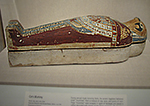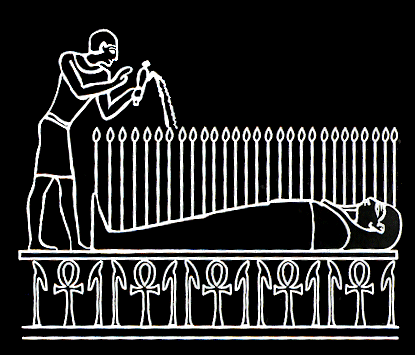October 12, 2008
"...the Egyptians say that Osiris is being buried at the time when the grain in sown and covered in the earth and that he comes to life and reappears when plants begin to sprout." (page 84)
"Also those who say that Osiris is being buried at the time when the grain is sown and covered in the earth and that he comes to life and reappears when plants begin to sprout." – (Plutarch, On Isis and Osiris 377c)
Corn-mummies and Osirian statues The Egyptians celebrated this 'planting' with the 'rites of Khoiak'. Jan Assmann tells more about these rites: The planting is a sort of death. Osiris must be buried so that he can rise again. It is the cycle of birth and rebirth both on mundane as well as mythological levels. So this is simply the earth's natural cycles. At first Set's role was understood to be a natural part of the cycles and within Ma'at. TeVelde explains "In itself, the dying of Osiris does not seem to be a wrong thing, for death is 'the night of going forth to life.'" (Book of the Dead) It is understood that "Out of death life arises: Later, because he was the favourite god of the Hyksos, who the Egyptians had had some trouble subduing, Set's role became seen as evil, the chaos that is outside Ma'at. But earlier, this was not so. Later, "The idea that Osiris had to go to the realm of the dead seems to have been accepted to some extent, but his death is to be deplored because he was murdered by Seth." (page 82) At first, the death at Set's hands is accidental, a by product of chaos. Later, it is viewed with plotting and trickery. Plutarch tells about a feast to which Set invites Osiris, but then later tricks him into laying down in a coffin. Once in, his death process begins. Even so, the trickery is a way to cause natural cycles. Gadalla quotes Plutarch: The story told of the shutting up of Osiris in the chest seems to mean nothing less than the vanishing and disappearance of water....at the time when....the Nile recedes to its low level and the land becomes denuded. As the nights grow longer, the darkness increases, and the potency of the light is abated and subdued. (Moralia Vol V 266, 39D) TeVelde explains, "As Re who manifests himself in the sun goes to rest in the evening and awakes from the sleep of death in the morning, so do the death and resurrection of Osiris seem to be equally inevitable and natural. In the famous conversation between Atum and Osiris about death and life in the hereafter the chief god finally says:"How perfect is that which I have done for Osiris in contradistinction from all gods. I have given him the realm of the dead and his son Horus as heir upon his throne on the Island of Fire" (Book of the Dead) via TeVelde, page 82) Osiris as God of the Dead had to die. From there, the views differ. There are those who see Set as "demonic initiator, who leads his brother to life through death by violence."(TeVelde, Page 98) But how did the original Setians view these events? So much of what the ancient Priesthood established has been later destroyed (or hopefully simply not discovered yet), yet we can make a surmise. The one who gives life, who plugs us into the electrical source is the one who unplugs us. The Hermetic magicians understood this, and in the spell Don Webb shares for this festival, the Hermeticist declared "I am ABRIAÔTH ALARPHÔTO SÊTH Ruler of the Kingdom of Gods, whose First Thought did create and destroy the gods after my manner of coming into being."(page 48) Fierce words to utter. Yet, it is so, a god may only die at the hands of another god. In the Egyptian pantheon, it was Set's job, the only one strong enough for the job. He was the only one who could do to Osiris that which needed done to make him King of the Realm of the Dead. Not only that, when we humans die, we all become as Osiris. And yet, there are more ways to view the cycle of death and rebirth than just literally as in death. There are many aspects to the mysteries of Osiris. If there is the planting, then there is the sprouting. As the ancients celebrated the planting, they also celebrated this aspect. It comes down to us in the Easter celebrations, after the spring equinox. I think about the cycle of birth and rebirth. In some religious/mystical understandings, they speak of a spiritual rebirth, when some aspect of an individual has undergone such transformation that it is like a rebirth. Old characteristics have died and been replaced with new characteristics. Thus we can view this festival as a ridding of stasis in our lives, getting rid of habits which do not serve us. If some aspect is not aiding my growth, I must face what it is, so that it can be transformed. Thus it is with this understanding that the Typhonian Hermeticist proceeds, whose spell Don Webb shares with us. The purpose of the symbolic re-enactment of the slaying is to obtain a Djam scepter. A block of green faience is shattered to obtain the scepter, always a symbol of sovereignty and obtaining power. Why green, you might ask? Possibly this is because in depictions of Osiris, he is often given a green hue. In the Hermeticist's spell, Set is seen as the avenging griffin. The Hermeticist says these words, "I am ABLANATHANALBA, the griffin who holds Osiris in his hand..."(page 48) Winged griffins have been found with the head of Set. TeVelde in "Seth, God of Confusion" quotes the demotic papryus Leiden I 384: "The griffin is the shepherd of everything living on earth, and the avenger upon whom there is no vengeance." In this form, Set slays stasis. Not always a welcome thing, even for those who know its necessity, sometimes Set is viewed as "disturber of the peace" (TeVelde). We get comfortable with stasis. We get 'used to' stasis. The known is comforting. But sometimes we are thrown, or throw our own selves into the Unknown. The unknown as an aspect of Darkness can be frightening. Yet it can be a powerful tool for growth. If we keep with the familiar, we do not grow. So it is a useful thing to examine ourselves and see what has become a form of inertia. What old attitudes do we need to get rid of? The Djam scepter is "the scepter of the future"(Webb). As I read about Egyptian faience, I learn it is ceramic material composed of crushed quartz. In the article at touregypt.net on Egyptian Faience, Marie Parsons explains that SCEPTERS could be made of faience. Quartz, in one of its many forms, was used for tools, as well. The Ancient Egypt magazine (Sept 2004), features an article on the use of flint in Dynastic Egypt. Flint tools had a religious purpose, in addition to their mundane uses. "Freshly knapped flint gives a cleaner, sharper cut than even iron." During this festival, one can imagine SET using a lightweight flint sickle blade on Osiris (who represents stasis). Curious to learn what flint is, I discovered flint (and chert) are non-gem varieties of cryptocrystalline-granular quartz. It is because it chips so easily that it can be made to hold such a sharp edge. Flint also produces a spark when it is struck by steel (or when IT strikes a steel object), due to the kinetic energy (the energy of motion) that is created. Getting rid of stasis creates some sparks! So old habits die and new habits are reborn. If there is the planting, then there is the sprouting. We can rejoice in this. And so I will not fear Set, the initiator who who brings us to life from death and who points out what is stasis, who will not let it paralysis. I will give heed, and in so doing obtain the scepter of Djam, which puts the power in my hands to bring about change.
October 16, 2015: Correction of Timing
The determination of October 16th refers to information in a book by Bob Brier. While this date might have been accurate for the year he wrote the book, because the ancient Egyptians were on a LUNAR calender, this date changes each year! Referring to a more accurate calendar, for 2015, the Khoiak Festival of "Hacking the Earth" occurs on November 22nd! The following seven day "Mysteries of Osiris (Wesir)" runs from November 24th to November 30th in 2015.
Just trying to keep things accurate!
Go back to Where the Light Shines Through 
Corn Mummy at Brooklyn Museum
"The god Osiris was closely associated with vegetation, and particularly with germinating grain. The emergence of young growth shoots from the fertile mud of Egypt was regarded as a powerful metaphor for human resurrection, and this notion was given physical form in Osirian images and figurines in which earth and corn were basic constituents. Some royal tombs of the New Kingdom contained an 'Osiris bed', a seed bed in a wooden frame or on a piece of textile, made in the shape of Osiris. This bed was planted with barley, which germinated in the tomb, symbolizing the renewal of life for the dead king via the agency of Osiris. A similar concept underlay the creation of 'corn mummies', figurines composed of earth or mud mixed with grains of barley and fashioned into a miniature mummiform image of Osiris. These figures were manufactured in an elaborate temple ritual during the month of Khoiak, and then buried in areas with sacred associations..."
(_Death and the Afterlife in Ancient Egypt_, by John H. Taylor, page 212)
"In Papyrus Jumilhac, a genuine 'priestly writing' in the biblical sense, which codifies all cultic knowledge regarding the eighteenth nome of Upper Egypt in a truly magnificent handwriting, the festival is called Khebes-Ta, 'Hacking up of the Earth,'..." (_Death and Salvation in Ancient Egypt_, by Jan Assmann, translated by David Lorton, page 363)
'I am Osiris...I have fallen upon my side, that the gods may live on me.'"(Coffin Text IV) via "Seth, God of Confusion" page 81)
"Osiris with 28 stalks of wheat growing out of his coffin" Gadalla, page 87
which he got from the Temple of Isis at Philae
- Note the foundation of ankh and was/djam scepters upon which Osiris and the attending Priest stand!
Go forward to Ma'at
Go to INDEX of Markings Of My Path
© Joan Ann Lansberry: